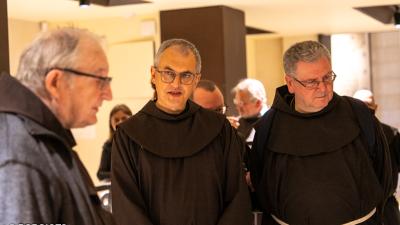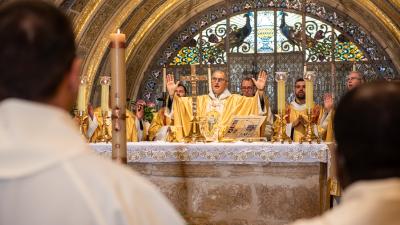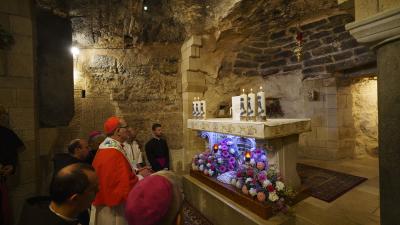
Following the steps of an ancient tradition, once again this year, the Basilica of St. Anne opened its doors to allow the pilgrims who came on this feast day to visit to participate in the Holy Mass celebrated in honor of the Nativity of the Blessed Virgin Mary, in the place where, according to the Protoevangelium of James, the residence of Joachim and Anne once stood.
Also called “Infancy Gospel,” the apocryphal gospel recounts the first years of Mary and places her parents’ home “not far from the Temple.” During the homily, Br. Stéphane Milovitch, head of the Cultural Heritage Office of the Custody of the Holy Land, spoke about the episode in which Joachim was chased out of the Temple because he had no offspring and [in which] he, who was heartbroken, decided to withdraw to the wilderness until the Lord revealed Himself to him, while Anne, who was sterile, prayed intensely to the Lord that He might bless her. God is moved by this story of tenderness so as to send an Angel into the desert to console Joachim and assure him [that he would have] a child, whom Anne consecrated to God.
Since the fifth century, pilgrims frequented this site identified as the place where the pool of Bethesda was located, as well as the church dedicated to “Mary where she was born.” Built in 1192, after the capture of Jerusalem and the reconquest of Saladin, the building was used as a Koranic school and it was made inaccessible to Christians. It was only in the fifteenth century that the Franciscans obtained a royal decree that allowed them to make a pilgrimage to the crypt twice a year – on December 8 and September 8. Because of the inaccessibility of the place to Christians, the friars were lowered by a rope from a window that is still visible from the outside.
After the Crimean War, in 1856, the building and the adjacent land were donated to France by the Sultan Abdul Majid and the restored Basilica was finally entrusted to the Institute of African Missionaries (White Fathers) in 1878. The relationship between France and the Basilica and between France and the Holy Land is highlighted by the participation of the French Consul, Pierre Cochard, in this and in several other liturgical celebrations linked to a specific protocol.
The historical episodes further attest to the[Franciscans’] desire to highlight the solemnity that is celebrated here today, at the place where they took place. They are a patient sign of a fruitful memory whose fruits are found in the present but also within the history of Salvation and in the writings of the fathers of the Church. This is confirmed by Br. Stéphane, affirming that the Church Fathers said “that Mary is to the Church what the dawn is to the firmament, [and that] Mary precedes the sun.” [Mary] becomes the origin of Salvation not only in her time but also and most especially in ours.”This day is the beginning and the consecration and we are all invited to give thanks.”
Giovanni Malaspina




